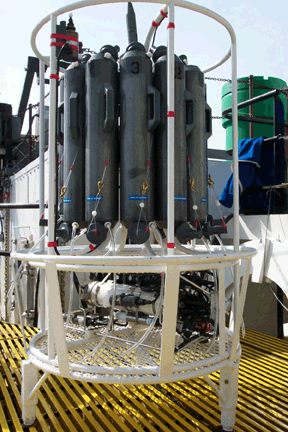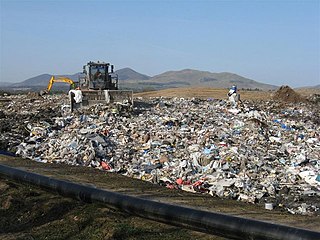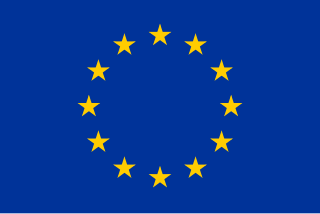
Water quality refers to the chemical, physical, and biological characteristics of water based on the standards of its usage. It is most frequently used by reference to a set of standards against which compliance, generally achieved through treatment of the water, can be assessed. The most common standards used to monitor and assess water quality convey the health of ecosystems, safety of human contact, extent of water pollution and condition of drinking water. Water quality has a significant impact on water supply and often determines supply options.

A bioindicator is any species or group of species whose function, population, or status can reveal the qualitative status of the environment. The most common indicator species are animals. For example, copepods and other small water crustaceans that are present in many water bodies can be monitored for changes that may indicate a problem within their ecosystem. Bioindicators can tell us about the cumulative effects of different pollutants in the ecosystem and about how long a problem may have been present, which physical and chemical testing cannot.
The best available technology or best available techniques (BAT) is the technology approved by legislators or regulators for meeting output standards for a particular process, such as pollution abatement. Similar terms are best practicable means or best practicable environmental option. BAT is a moving target on practices, since developing societal values and advancing techniques may change what is currently regarded as "reasonably achievable", "best practicable" and "best available".

The European emission standards are vehicle emission standards for pollution from the use of new land surface vehicles sold in the European Union and European Economic Area member states and the United Kingdom, and ships in EU waters. The standards are defined in a series of European Union directives staging the progressive introduction of increasingly stringent standards.

Landfills in the United Kingdom were historically the most commonly used option for waste disposal. Up until the 1980s, policies of successive governments had endorsed the "dilute and disperse" approach. Britain has since adopted the appropriate European legislation and landfill sites are generally operated as full containment facilities. However, many dilute and disperse sites remain throughout Britain.
Water supply and sanitation (WSS) in the European Union (EU) is the responsibility of each member state, but in the 21st century union-wide policies have come into effect. Water resources are limited and supply and sanitation systems are under pressure from urbanisation and climate change. Indeed, the stakes are high as the European Environmental Agency found that one European out of ten already suffers a situation of water scarcity and the IEA measured the energy consumption of the water sector to be equivalent to 3,5% of the electricity consumption of the EU.

The Water Framework Directive (WFD)2000/60/EC is an EU directive to establish a framework for the protection of all water bodies (including marine waters up to one nautical mile from shore) by 2015. The WFD establishes a programme and timetable for Member States to set up River Basin Management Plans by 2009.

Directive 89/391/EEC is a European Union directive with the objective to introducing measures to encourage improvements in the safety and health of workers at work. It is described as a "Framework Directive" for occupational safety and health (OSH) by the European Agency for Safety and Health at Work.

Environmental monitoring is the processes and activities that are done to characterize and describe the state of the environment. It is used in the preparation of environmental impact assessments, and in many circumstances in which human activities may cause harmful effects on the natural environment. Monitoring strategies and programs are generally designed to establish the current status of an environment or to establish a baseline and trends in environmental parameters. The results of monitoring are usually reviewed, analyzed statistically, and published. A monitoring program is designed around the intended use of the data before monitoring starts.

The Urban Waste Water Treatment Directive 1991 European Union directive concerning urban waste water "collection, treatment and discharge of urban waste water and the treatment and discharge of waste water from certain industrial sectors". It aims "to protect the environment from adverse effects of waste water discharges from cities and "certain industrial sectors". Council Directive 91/271/EEC on Urban Wastewater Treatment was adopted on 21 May 1991, amended by the Commission Directive 98/15/EC.

The Waste Framework Directive (WFD) is a European Union Directive concerned with "measures to protect the environment and human health by preventing or reducing the adverse impacts of the generation and management of waste and by reducing overall impacts of resource use and improving the efficiency of such use". The first Waste Framework Directive dates back to 1975. It had previously been substantially amended in 1991 and 2006. The present directive was adopted on 19 November 2008.

Environmental issues in the European Union include the environmental issues identified by the European Union as well as its constituent states. The European Union has several federal bodies which create policy and practice across the constituent states.

The term environmental persistent pharmaceutical pollutants (EPPP) was first suggested in the nomination in 2010 of pharmaceuticals and environment as an emerging issue in a Strategic Approach to International Chemicals Management (SAICM) by the International Society of Doctors for the Environment (ISDE). The occurring problems from EPPPs are in parallel explained under environmental impact of pharmaceuticals and personal care products (PPCP). The European Union summarizes pharmaceutical residues with the potential of contamination of water and soil together with other micropollutants under "priority substances".
Technical Guidance WM2: Hazardous Waste: Interpretation of the definition and classification of hazardous waste is a guidance document developed and jointly published by the English Environment Agency, Natural Resources Wales, Scottish Environment Protection Agency and the Northern Ireland Environment Agency to provide guidance on the assessment and classification of hazardous waste based on the revised Waste Framework Directive definition of hazardous waste. Waste producers, consultants, contractors and waste management companies use the guidance to a) identify the correct waste code for their waste and b) determine whether the waste is hazardous or not based on its chemical composition.
Since the late 1970s, the European Union's (EU) policy has been to develop and drive appropriate measures to improve air quality throughout the EU. The control of emissions from mobile sources, improving fuel quality and promoting and integrating environmental protection requirements into the transport and energy sector are part of these aims.

A pesticide, also called Plant Protection Product (PPP), which is a term used in regulatory documents, consists of several different components. The active ingredient in a pesticide is called “active substance” and these active substances either consist of chemicals or micro-organisms. The aims of these active substances are to specifically take action against organisms that are harmful to plants. In other words, active substances are the active components against pests and plant diseases.
International Commission for the Protection of the Rhine (ICPR) and its contract shows alignment with the UN Convention on international watercourses and has proven effective in its goals for the Rhine and the Rhine Basin. It was necessary for a treaty to come through the countries in the Rhine basin as it provides water based on industrial and agricultural needs and provides drinking water to over 20 million people.

Denmark consists of the northern part of the Jutland peninsula and an archipelago of 406 islands bordering both the Baltic Sea and North Sea, and has substantial maritime influence. This prominence is attributed to its expansive coastline, which is the 17th longest in the world, alongside a sizeable Exclusive Economic Zone and role as an Arctic power. Denmark is also home to Mærsk, the world's second largest shipping company and Ørsted, an industry leader in offshore wind, and ranks as the fifth largest seafaring nation in the world[When?].









